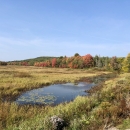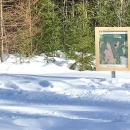About Us
Carlton Pond Waterfowl Production Area (WPA) is located in central Maine's Waldo County. Waterfowl production areas are wetlands (and surrounding uplands) that provide breeding, resting, and nesting habitat for waterfowl, shorebirds, water birds, and other wildlife. About 95 percent of the Nation’s waterfowl production areas occur in the prairie potholes region of the Midwest (USFWS 2007). Carlton Pond WPA is the only waterfowl production area waterfowl production area
Waterfowl production areas are small natural wetlands and grasslands within the National Wildlife Refuge System that provide breeding, resting and nesting habitat for millions of waterfowl, shorebirds, grassland birds and other wildlife. Virtually all waterfowl production areas are in the Prairie Pothole Region states of Iowa, Minnesota, Montana, North Dakota and South Dakota.
Learn more about waterfowl production area in the U.S. Fish and Wildlife Service’s (Service) North Atlantic-Appalachian Region.
The creation of Carlton Pond WPA was authorized by administrative action on July 15, 1964, and the WPA was officially established when the first parcel was acquired on November 24, 1965, under the authority of the Migratory Bird Conservation Act and Migratory Bird Hunting and Conservation Stamp Act. The 1,068-acre Carlton Pond WPA is managed as part of the Northern Maine Complex National Wildlife Refuge.
Our Mission
Each unit of the National Wildlife Refuge System is established to serve a statutory purpose that targets the conservation of native species dependent on its lands and waters. All activities on those acres are reviewed for compatibility with this statutory purpose.
Carlton Pond Waterfowl Production Area (WPA) was authorized by administrative action on July 15, 1964. The WPA was officially established when the first parcel was acquired on November 24, 1965, under the authority of the Migratory Bird Conservation Act and Migratory Bird Hunting and Conservation Stamp Act. The intent was to provide primarily breeding habitat for waterfowl, as well as benefitting shorebirds, water birds, and other wildlife. The 1,068-acre Carlton Pond WPA is managed to protect the Service's "trust resources" which include migratory birds, endangered species, and wetlands. By improving habitat, the Service ensures that wildlife will thrive on the area.
The purposes for which Carlton Pond WPA was established are:
• “...as Waterfowl Production Areas subject to… all of the provisions of such Act [Migratory Bird Conservation Act]...except the inviolate sanctuary provisions...” 16 U.S.C. 718(c) (Migratory Bird Hunting and Conservation Stamp Act).
• “...for any other management purpose, for migratory birds.” 16 U.S.C. 715(d) (Migratory Bird Conservation Act).
Our History
In 1850, rock dam was built near the site of the existing dike and water control structures, to power a local sawmill. The US Fish and Wildlife Service rebuilt the dam in 1972 to facilitate manipulating the water levels to provide habitat for nesting waterfowl, marsh and water birds, and other wildlife. Water control structures were rehabilitated with assistance from Ducks Unlimited in 1996.
As a Waterfowl Production Area the rules and regulations are different from a national wildlife refuge national wildlife refuge
A national wildlife refuge is typically a contiguous area of land and water managed by the U.S. Fish and Wildlife Service for the conservation and, where appropriate, restoration of fish, wildlife and plant resources and their habitats for the benefit of present and future generations of Americans.
Learn more about national wildlife refuge . Carlton Pond WPA is open to public hunting, fishing, and trapping under State Law without the need for additional permits. Other activities may be permitted as long as they are compatible with the purposes for which the area was established.
Other Facilities in this Complex
Carlton Pond Waterfowl Production Area is managed as part of the Northern Maine National Wildlife Refuge Complex, along with Moosehorn National Wildlife Refuge, Aroostook National Wildlife Refuge, and Sunkhaze Meadows National Wildlife Refuge.




